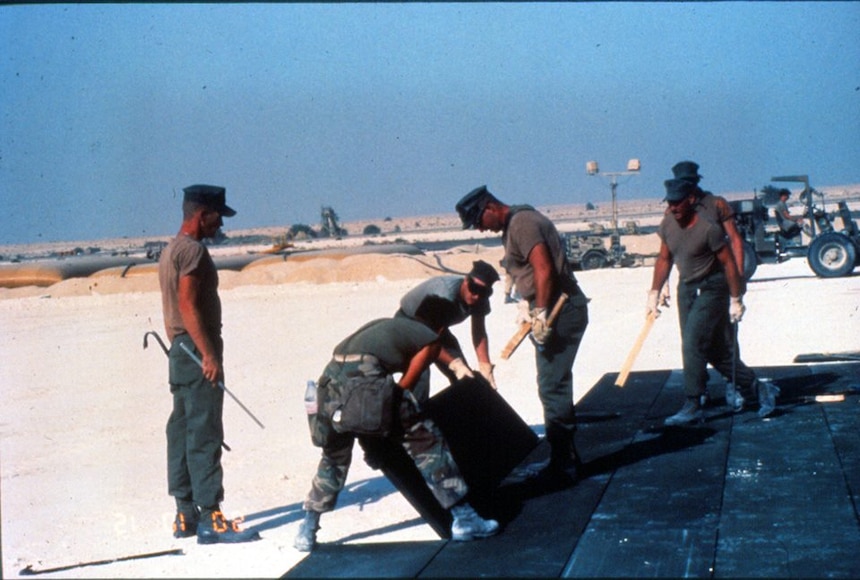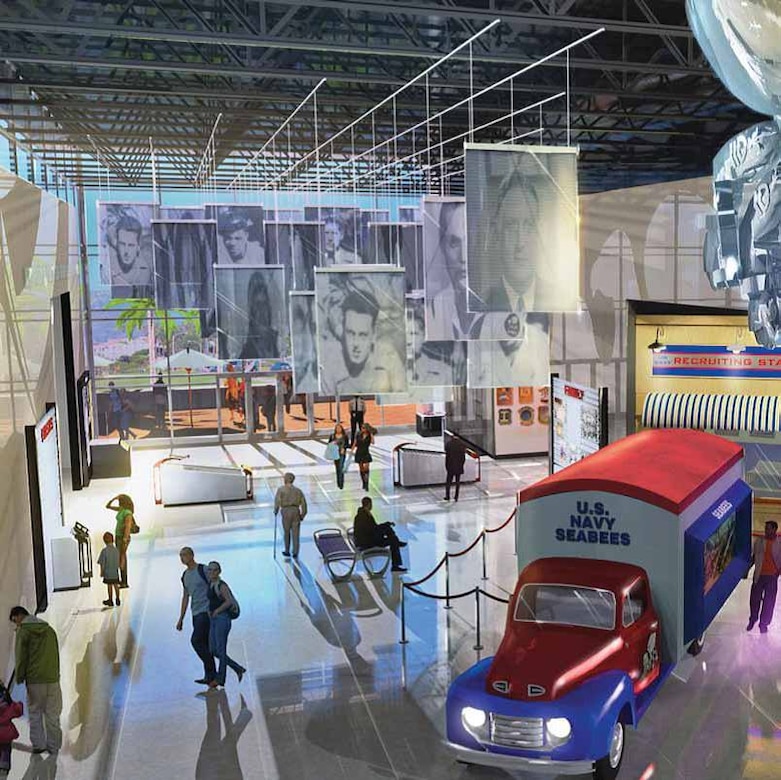Operation "Desert Shield/Desert Storm" - On 2 August 1990 the armed forces of Iraq began the invasion and subsequent conquest of the Emirate of Kuwait. Under United Nations' auspices, the United States and other member nations responded by deploying military forces to Saudi Arabia. The immediate goal was to forestall further Iraqi aggression; the long-range goal was to compel Iraq to withdraw from Kuwait. The initial allied military undertaking to protect Saudi Arabia was dubbed Operation "Desert Shield."
Among the U.S. forces deployed to the region was the First Marine Expeditionary Force. Seabees were to provide construction support for this force. On 7 August the Seabees began preparations to deploy four battalions to the region: Naval Mobile Construction Battalion 4, 5, 7, and 40. On 13 August the first Seabees arrived in Saudi Arabia, an element of Amphibious Construction Battalion 1, comprising 210 personnel. These men immediately went to work unloading Marine Corps equipment and supplies from Maritime Prepositioned Force ships.

During the period 10-20 August, 100 Seabees of Amphibious Construction Battalion 2 departed Norfolk, Virginia, on amphibious ships bound for the Persian Gulf. While in the gulf these Seabees participated in numerous exercises with the Marines to prepare for an amphibious assault in the region.
The second wave of Seabees to arrive were personnel from Construction Battalion Units 411 and 415; they erected and maintained Fleet Hospital Five, a 500-bed hospital facility at Al Jubail, Saudi Arabia. Both units had female Officers in Charge, marking a first for the Seabees.
August 22
1951: Naval Mobile Construction Battalion (NMCB) 7 commissioned at Construction Battalion Center (CBC) Davisville, Rhode Island.
1954: The French Colonial Forces were defeated at Dien Bien Phu in French Indo-China, May 7, 1954. In accordance with the Geneva Convention of July 21, 1954, Indo-China became a number of sovereign states: Laos, Cambodia and Vietnam. In addition, Vietnam was divided into two, thus creating North and South Vietnam, roughly at the 17th parallel. The truce agreement declared that the people of the two Vietnams should be permitted to reside in the country of their choice, and the United States was asked to provide transportation for the anticipated mass migration from Communist North Vietnam to free South Vietnam. The U.S. Navy was given the task of providing transportation for the migrants, and Seabees of Amphibious Construction Battalion (ACB) 1 were charged with installing and operating pontoon bridges where necessary and building campsites for the refugees. However, when the amphibious Seabees arrived in Haiphong on August 22, 1954, they learned that the truce agreement signed in July prohibited the landing of foreign military units in Vietnam. Thus, the Seabees were prevented from operating until all military insignia was removed from uniforms and equipment; some even donned nondescript clothing. Then they returned to their tasks. The Seabees not only assisted in moving several hundred thousand Vietnamese and their possessions, but also built camps that contributed to the refugees comfort. While assisting the Vietnamese in their mass migration, the Seabees helped French troops evacuate the country and built a recreation center in the south for U.S. 7th Fleet personnel engaged in the operation. ACB 1 Seabees who participated in Operation Passage to Freedom were commended by the Task Force Commander.
1967: The NMCB 4 advance party, commanded by Lt. R.B. Thatcher, Civil Engineer Corps (CEC) departed Camp Hoover for the Continental United States (CONUS).
August 25

2009: Groundbreaking ceremonies are held at Naval Base Ventura County, Port Hueneme, California, for construction of the new U.S. Navy Seabee Museum to replace the older facility which opened in 1956.
August 26
1943:105th NCB formed at Naval Construction Training Center (NCTC) Camp Peary, Magruder, Virginia.
1944:302nd NCB formed at Maui, Hawaii.
1967:Capt. J.M. Hill, CEC,relieved Cmdr. R.L. Foley, CEC,as commander, 32nd Naval Construction Regiment (NCR).
1968:Seabee William Darrah, State Departments Naval Support Unit, was highly commended for heroic efforts in extinguishing what could have been a major fire at the U.S. Embassy in Prague, Czechoslovakia. Due to a curfew, the local fire department was unavailable. In response, the members of the embassy staff, U.S. news correspondents and private American citizens formed a bucket brigade, and managed to control and extinguish the fire. The U.S. Ambassador to Czechoslovakia said, By general agreement, the person who merits the highest praise is Seabee William B. Darrah, who knew his job thoroughly and showed great personal courage.
August 27
1965:NMCB 8 transferred to Commander, Naval Construction Battalions, U.S. Pacific Fleet (COMCBPAC), from Commander, Naval Construction Battalions, U.S. Atlantic Fleet (COMCBLANT).
1970:Seabee Teams 0106 and 0107 departed Davisville, Rhode Island, for reassignment to OIC Construction Battalions, U.S. Pacific Fleet Detachment (CBPACDET), RVN, and deployment to Ham Tan and Tan An, respectively.
1971:Underwater Construction Team (UCT) 1 returned from U.S. Naval Ammunition Depot, Earle, Colts Neck, New Jersey.
2010:Capt. Joe Grealish, CEC, relieved Capt. Paul Webb, CEC, as commanding officer, ACB 2, at Joint Base Little Creek-Fort Story, Virginia.
August 28
1942: The 21st Naval Construction Battalion (NCB) was commissioned at Camp Bradford, Norfolk, Virginia.
1943: The 117th NCB was commissioned at Naval Construction Training Center (NCTC) Camp Peary, Magruder, Virginia.
1967: At 6:08 a.m., the Dong Ha Combat Base in the Republic of Vietnam (RVN) was subjected to an enemy rocket attack. Three of the rockets landed in the Seabee cantonment, Camp Barnes. One of the rockets made a direct hit on a C Company berthing hut. As a result of this direct hit, four men were killed: Builder (Concrete) 2nd ClasssJerry L. Newman, Builder (Concrete) Constructionman Jerome D. Patterson, Builder (Concrete) Constructionman Anthony K. Grasso, and Builder (Heavy) Construction ApprenticeRichard J. Wager. Between August 28 and September 25, 1967, the Seabee camp at the Dong Ha Combat Base came under enemy artillery and rocket attack 47 times on 13 different days. All attacks came between 4 a.m. and 8 p.m, with the majority of them coming during daylight hours. As a result of these daytime attacks, construction work was greatly hampered, and sometimes came to a standstill while the Seabees sought cover.
1967: One man from Naval Mobile Construction Battalion (NMCB) 1 was killed by enemy sniper fire on Route 1.